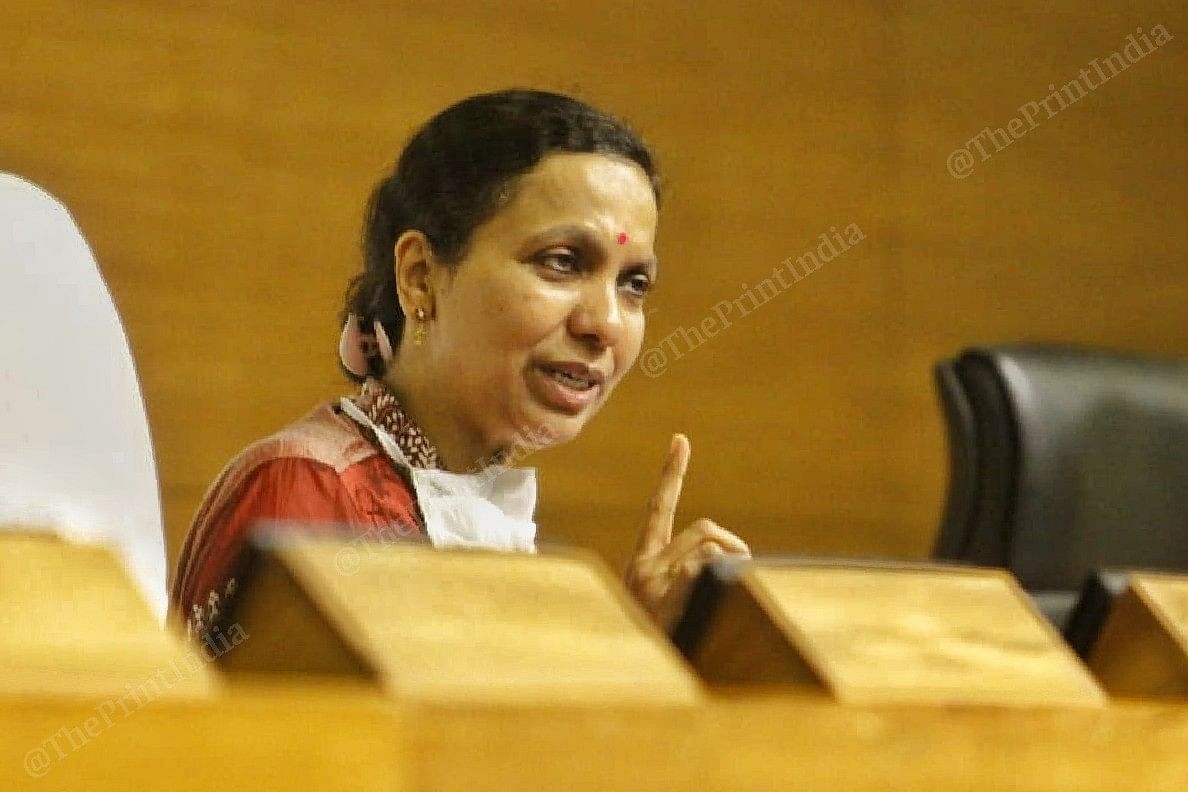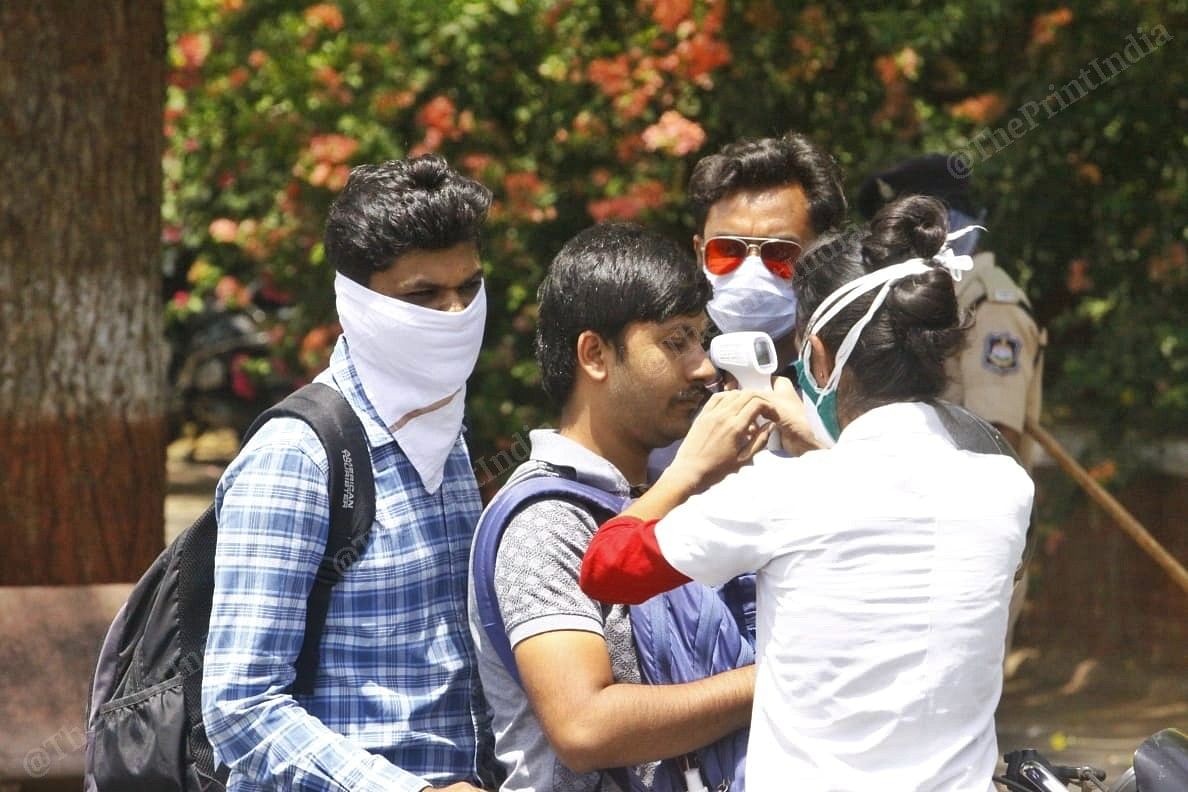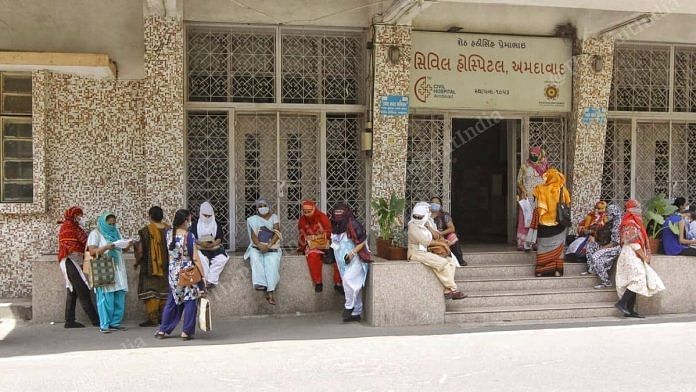Ahmedabad: Gujarat, lauded in the past for its development model, now reports the second highest number of Covid-19 cases in India — while Maharashtra has recorded the highest at 8,068, Gujarat follows with 3,301 as of Monday.
But it’s a number that looks worse when seen in the context of the population of the two states — the population of Gujarat is 6.27 crore, a little over half of Maharashtra’s 11.42 crore.
And the graph is steadily rising too. Over the last seven days, Gujarat has been among the states, recording a dramatic spike in cases. Among the latest casualties in the state is Congress MLA Badruddin Shaikh, who passed away Sunday night.
Gujarat’s performance has been a cause for puzzlement given it has recorded the slowest rate of recovery (7.44 per cent) among Covid-19 patients and has among the highest rates of death (4.1 per cent) in the country, despite having one the best health infrastructures.
Health experts and officials suggest a variety of reasons could be causing this — from a new strain of the virus to a lack of political leadership.
Also read: India’s testing strategy is right, we have increased the numbers significantly: AIIMS chief
Issues in leadership
Former health minister of Gujarat, Jay Narayan Vyas, said the state’s response to the pandemic “doesn’t explain” its track record given that the same health infrastructure was able to tide over outbreaks of swine flu, ebola, and Crimean-Congo hemorrhagic virus.
“The data seems to suggest that the worst is yet to come,” he said. “Since over 90 per cent of the cases are in cities, it should have been easier to handle, but it doesn’t seem to be getting contained despite all the government’s efforts,” he told ThePrint.
The pandemic has resulted in Chief Minister Vijay Rupani being quarantined after he interacted with an MLA who was later tested positive for the virus. Deputy Chief Minister Nitin Patel, who also holds the health ministry portfolio, occasionally addresses the media and public with updates on the situation. However, principal health secretary Jayanti Ravi and Ahmedabad Municipal Commissioner Vijay Nehra have become the most prominent faces in the state’s battle against the virus.
“For a change, the entire fight is being led by the bureaucracy, and it’s doing its level best no doubt. But the limitation of the bureaucracy is that it has limited public appeal. A political leader going around and asking people to stay inside will go a long way, but this is where we’re seeing a breakdown in political leadership,” Vyas said.
Also read: Roads got built, pending works done: Why Gujaratis now want more Trump-like VVIP visits
First there were two
The first instance of the virus in the state was recorded in two patients on 19 March, a few days before the nationwide lockdown was announced. The two had a travel history — the first from Saudi Arabia and the second from London. In a matter of weeks, cases were being recorded in thousands.
A bulk of these cases, approximately 63 per cent, are emerging from Ahmedabad’s hotspot zones in the city’s more ghettoised parts, where lower to middle class Muslims live. Officials have said that the cases rose after those attending the Tabligi Jamaat congregation in New Delhi in mid-March returned to their home states. On 5 April, five members of the Jamaat tested positive in Ahmedabad.
“We had a lot of people come from Delhi. But we treated it as a health issue, not as a law and order issue,” Ahmedabad’s municipal commissioner Vijay Nehra told ThePrint. “We had prepared for an outbreak as early as 24 January, when we started training our paramedics and doctors and started sourcing supplies like PPE.”

Gujarat government data says it has 10,500 beds on standby just for Covid-19 patients. Another 22,385 beds are available for less complicated patients and as quarantine facilities. The state has been expanding its daily testing capacity every week, and now stands at 3,770.
Though the Gujarat government has made assurances that it can handle the upward trend, reports of positive patients (including police officers) not being allotted beds for hours and complaints by medical staff about inadequate protective gear and testing for themselves indicates a sense of unpreparedness.
Also read: India doesn’t want taali-thali charity from billionaires, it wants Socialist state to act
Is there community transmission?
The Gujarat government has also denied the possibility of community transmission, defined by the Indian Council of Medical Research (ICMR), the country’s apex medical research body, as the scenario where 20-30 per cent of cases can’t be traced. But not all health experts agree.
“They’re using an artificial definition of community transmission. In the poorest pockets of Ahmedabad, the cases have gone well beyond local transmission,” a public health expert from the Public Health Foundation of India told ThePrint on the condition of anonymity. “Those pockets now need to be monitored, because it’s likely that a lot of people are infected but asymptomatic.”
ThePrint had reported that some family members of positive patients had been left out of being tested in Behrampura, another hotspot.
Also read: ‘Low testing, no healthcare’ — residents of Ahmedabad’s hotspots cry for govt help
Behind Gujarat’s high death rate
Principal secretary of health, Jayanti Ravi, has attributed the high rate of deaths to the high number of co-morbid patients in the state. She said information gathered by scientists suggested that a different strain of the novel coronavirus could be another reason for the state’s slow rate of recovery.
“Dr Atul Patel, a competent authority, has evidence to say that the strain of the virus which is coming from the people who had undertaken international travel (and returned) to Kerala is likely to be different from the one which has come to Gujarat,” she said, adding, “Therefore there is such a possibility that the recovery rates are a little slower here compared to some of the other states,” she said.
Dr Patel, a clinician who consults for the Gujarat government, is a member of the ICMR’s research committee. Speaking to ThePrint, he said that ongoing research indicates that the L strain of the virus — a more pathogenic strain with higher transmission capacity — could be behind the state’s slow recovery and high death rates. He explained that once the virus left Wuhan, it began to mutate. Among the mutated strains is the S strain, which Patel said is less pathogenic.

“Unlike Kerala, which saw returnees mostly from Dubai, we have travellers from all over, including Europe and New York. The S strain is what seems to have affected those in Dubai and Kerala. We believe that in Gujarat people are affected by both L and S strains, and those with S are recovering more quickly,” Patel told ThePrint, adding, “We have not come to any definitive conclusions. We are working on the research and samples.”
But these claims and suspicions about strains and more dangerous mutants have been clearly debunked by global experts. Virologists have repeatedly said there is just one strain of the novel coronavirus. Regular mutations appear in the virus as it evolves and transmits, forming different ‘clades’, but they offer no extra immunity or virulence, according to experts.
Soumya Swaminathan, WHO’s chief scientist, has said that although different clades of the virus are prevalent in different geographical locations, she dismissed that they made “any differences in clinical outcome, mortality, virulence, or transmissibility”.
“(There is so far) No evidence that strains have anything to do with virulence or clinical severity,” Swaminathan said in a text message when reached by ThePrint Monday.
The public health expert quoted above said that without definitive research and data, however, drawing conclusions about Gujarat’s high death rates is impossible.
“We just don’t know why this is happening. One reason could be that people are reporting late. We are finding that once people are in the hospital, their condition deteriorates quickly and then they die,” he said.
Also read: Government-run Gujarat institute identifies 3 new mutations of novel coronavirus
‘Cycle of fear’
In Jamalpur, one of Ahmedabad’s hotspot clusters that has seen more than 250 cases of Covid-19, former MLA Sabirbhai Kabliwala said several people feared reporting symptoms, ironically because they did not want to die.

“Many people who went to the hospital came out dead. And so it’s a cycle of fear that is keeping people from reporting their symptoms. Keep in mind that these are uneducated, poor people. They often report when the virus has left them incredibly weak,” he told ThePrint. “People are in absolute panic in these pockets, because the number of deaths has more than doubled. Since people are not reporting, they don’t know if it’s due to Covid or other reasons,” he said.
Kabliwala added that the pockets ought to be strictly monitored and residents counselled so as to reduce panic. Jamalpur alone is home to some 2 lakh people.
“No one is visiting these areas, and that needs to start happening now. People need to be convinced to go into quarantine facilities,” he said.
Also read: Covid vaccine could come in a year, but life-as-usual years away, says WHO chief scientist




Heartfelt concerns for our Gujarati friends. Hope the situation soon starts improving ; I have some personal good friends in Gujarat. But if it were another state and another state government, the BJP would have wasted no time in putting full blame on the organizers of the NAMASTE TRUMP event which happened much after the Corona menace had already begun.
Looks like minimum 4 to 6 months lock down inevitable for Ahmedabad considering the Corona fire spread in the city.
India in terms of number of test conducted per million was between 250-300 per million. We still don’t know how many of those were antigen/ antibody tests due to the deliberate opaqueness of Indian diagnostic data. Compare this with 13,000 per million in USA. India has so far tested roughly about 0.049% (6,65,819) of its population. Compare this with Iceland’s 10% or Germany’s 2.5% (2.07 million) or US’s 1.7% (5.46 million) of their population. India will NEVER be able to expand its testing capacity due to bureaucratic intransigence and incompetence. A better option in the light of lesser reported fatalities is to lift the lock down and let nature run its course. If a miracle happens, then it will be in spite of government not due to government.